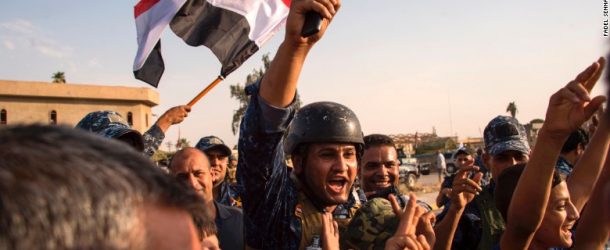Is it the end of DAESH (ISIS)? It is difficult to see how the group could return after the recapturing of Raqqa and Mosul, but the quick rise and apparent fall of ISIS has plagued the region with horrific crimes and mass destruction while planting the seeds of sectarian strife. It can be argued that the chief strategic outcome from the existence of ISIS was that the regional gates were left wide open for global and major regional powers to return and become active.
Al-Qaeda has avoided providing geographic targets (which can be easily attacked), relying instead on the difficulty of defeating its ideology. For that reason and in spite of their rivalry, al-Qaeda had warned ISIS about the perils of declaring a territorial caliphate. ISIS controlled more than 34,000 square miles in Syria and Iraq in 2014, from the Mediterranean coast to south of Baghdad. But with a massive transformation of the maps of Syria and Iraq, things look quite different today.
It took almost three years for the Syrian regime (backed by Russian forces, Iranian-backed militias, and Hezbollah), the Syrian Democratic Forces (backed by the US), the Free Syrian Army (backed by Turkey and Qatar), Kurdistan’s Peshmerga fighters, the Iraqi armed forces and the Popular Mobilization Forces (PMF) (backed by Iran and Iranian militias) in addition to the coalition of 69 countries against DAESH to halt this calamity and put an end to the existence of the so-called caliphate.
The demise of ISIS, but also its establishment, rise and expansion, all carry the clear fingerprints of regional and global powers. During the US occupation of Iraq a few years ago, ISIS was nothing but a small offshoot of al-Qaeda in Iraq (AQI) founded by Abu Musab al-Zarqawi. After the assassination of Zarqawi, the new leader Abu Ayyub al-Masri announced the creation of the Islamic State of Iraq (ISI) in 2006. Abu Omar al-Baghdadi led the terrorist organization until his death and the advent of the new, well-known leader Abu Bakr al-Baghdadi in 2010. It took Baghdadi three years to absorb the al-Qaeda backed militant group in Syria, Jabhat al-Nusra (or al-Nusra Front) and to call their combined forces the Islamic State in Iraq and the Levant (Daesh, ISIL or ISIS). The organisation decided to withdraw their allegiance from their parent terrorist organization, al-Qaeda, and the latter renounced ties to IS after months of infighting with al-Nusra Front. ISIS expanded and was able to swiftly overrun large swathes of land in Syria and Iraq.
In my opinion, the turning point in the life cycle of ISIS was an incident at the infamous US-designed Abu Ghraib jail in Iraq. A suspicious mass jailbreak of some 500 convicted senior members of al-Qaeda (who had all received death sentences) took place in June 2013. According to many observers, this escape from a supposedly highly-security prison produced the backbone for the surge in ISIS operations. A few months after the jailbreak, ISIS was able to capture one-third of Iraq, and in less than one year later, in June 2014, it took control of Mosul and Tikrit.
The conquest of Mosul constituted a dilemma. Iraq’s second-largest city was guarded by 60,000 security officers, including 30,000 trained soldiers (two divisions) and 30,000 federal police officers. On the other side, the number of ISIS attackers was estimated at between 800–1,500 insurgents. In other words, Iraqi official forces outnumbered ISIS fighters by more than 15 to 1. To add insult to injury, the battle of Mosul lasted for six days. Baghdad could have easily dispatched further divisions and artillery, and could have called on air support (from the US and others). The fall of Iraq’s oil-rich city of Mosul, which had more than $400 million (€322.6) in cash, appears unequivocally to have been a handover.
These developments leave us with no explanation but that the expansion and contraction of ISIS was orchestrated. For example, consider the deployment of Hezbollah Shiite militants in Syria. Hezbollah has been classified as a terrorist organization by many Western powers and even by a number of Arab countries. Israel also views Hezbollah and its forces as an imminent threat. Nevertheless, Hezbollah was able to deploy thousands of troops from Lebanon to Syria and to cross an international border with no serious reaction or criticism.
Similarly, little attention has been paid to the fact that tens of thousands of ISIS foreign fighters found their way smoothly into Iraq and Syria, while almost every army and intelligence agency on the planet (and all of their satellites) were watching. At a press conference on 17 October 2017, US Army colonel Ryan Dillon, a spokesman for the US-led coalition, said that the flow of foreign ISIS recruits had gone from about 1,500 fighters a month down to nearly zero today. This fact alone raises many concerns over the potential role of certain regional and global powers in easing the entry and/or exit of ISIS militants.
According to US assessments, 40,000 foreign fighters had joined ISIS by 2014. Assuming that the number of locals (ISIS fighters from Iraq, Syria and neighbouring countries) is at least close to that number, ISIS had at least 70,000 to 80,000 fighters in Syria and Iraq. But recent numbers have shown that in the two biggest cities – Mosul and Raqqa – there were no more than 2,000 dead bodies of ISIS fighters, and the remnants of ISIS in Iraq and Syria can’t be more than 15,000. Were the remaining 65,000 killed? No. Sound logic tells us that either the US exaggerated ISIS’ manpower in order to magnify the group’s danger, or foreign recruits were helped to escape.
By the same token, one might argue that US Special Forces airdrops in Deir ez-Zor a few months ago were undertaken to evacuate agents and ISIS loyalists before the arrival of the Russians and their allies. Russia has recently accused the Americans of conspiring with ISIS to take over the eastern areas of the city of Deir ez-Zor and the euphrates before the Syrian regime and its allies could reach it. In fact, the occupation of al-Omar oil field by US-backed Syrian Democratic Forces before the arrival of the Syrian regime forces, even though the latter were closer to it (3 kilometres), raises a lot of doubts, especially when considering the qualms of Sergey Lavrov regarding the withdrawal of ISIS from the province of al-Hasakah for the benefit of Americans.
Strategically, one can say that ISIS and the slogan of fighting terrorism gave a useful cover to many countries: the US’ return to Syria and Iraq, Russia’s intervention in Syria, Iran’s official presence in Syria and Iraq, and the activities of other regional powers including Turkey, Israel, Saudi Arabia, UAE and Qatar. The prolonged existence of an ISIS pseudo-state served the interests of intervening powers perfectly. Iraq’s and Syria’s military and resources were weakened, the capabilities of Shiite fighters (Hezbollah and Iran’s Revolutionary Guards) and Sunni militants (ISIS, al-Qaeda and al-Nusra Front) were depleted, the spheres of influence among the various powers were redesigned, dependency on foreign powers for military and political support was extended, and finally the resources − mainly oil − of the region were exploited and abused. According to several reports, ISIS’ main revenue came from oil production and smuggling, and oil trade included secret deals between ISIS and other major players, including the Syrian government.
To sum up, it is my contention that the chaos and anarchy that resulted from the presence of ISIS was, in essence, supported by regional and global powers. Each of these players was seeking to expand and capitalize on their intervention in terms of a long-term military presence and economic benefits. And the threat of ISIS has not vanished. If the organisation has proven anything over the past decade, it is that it has the ability to recruit new members. And failed and fragile states constitute fertile environments for terrorist organizations and radicals to regroup and expand.
The article originally appeared on http://eastwest.eu/en/eastwest-76/who-stands-to-gain-from-islamic-state.
Fadi ELHUSSEINI

























































One Comment »